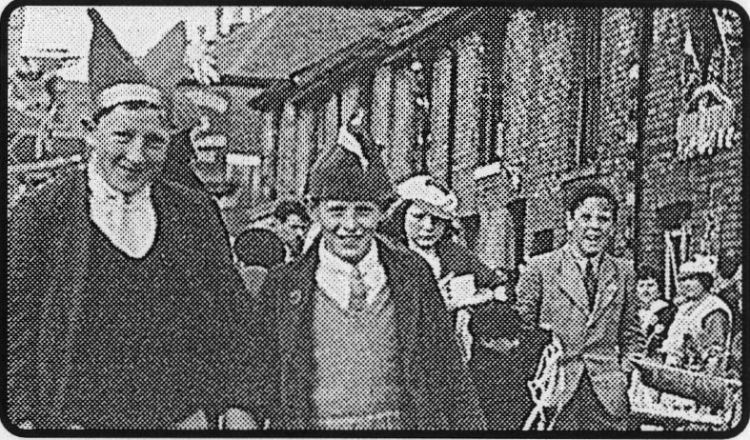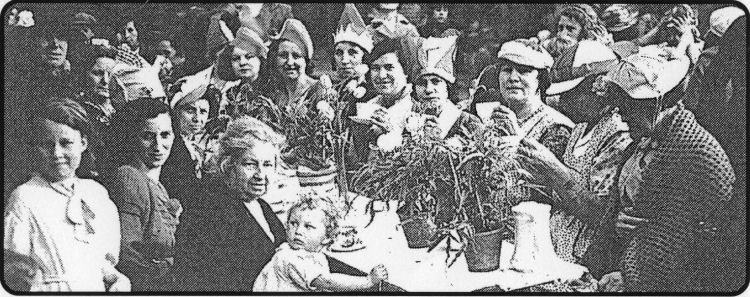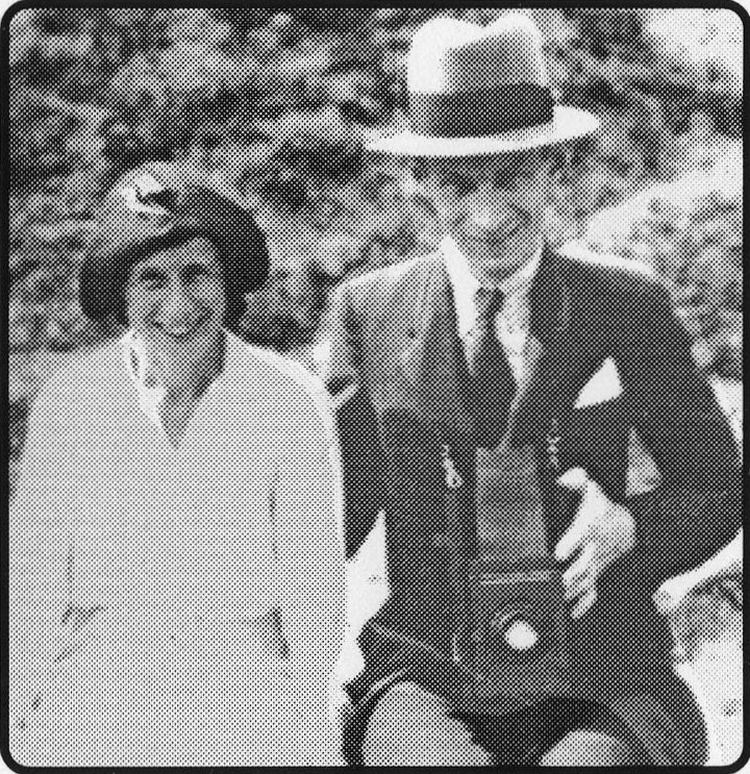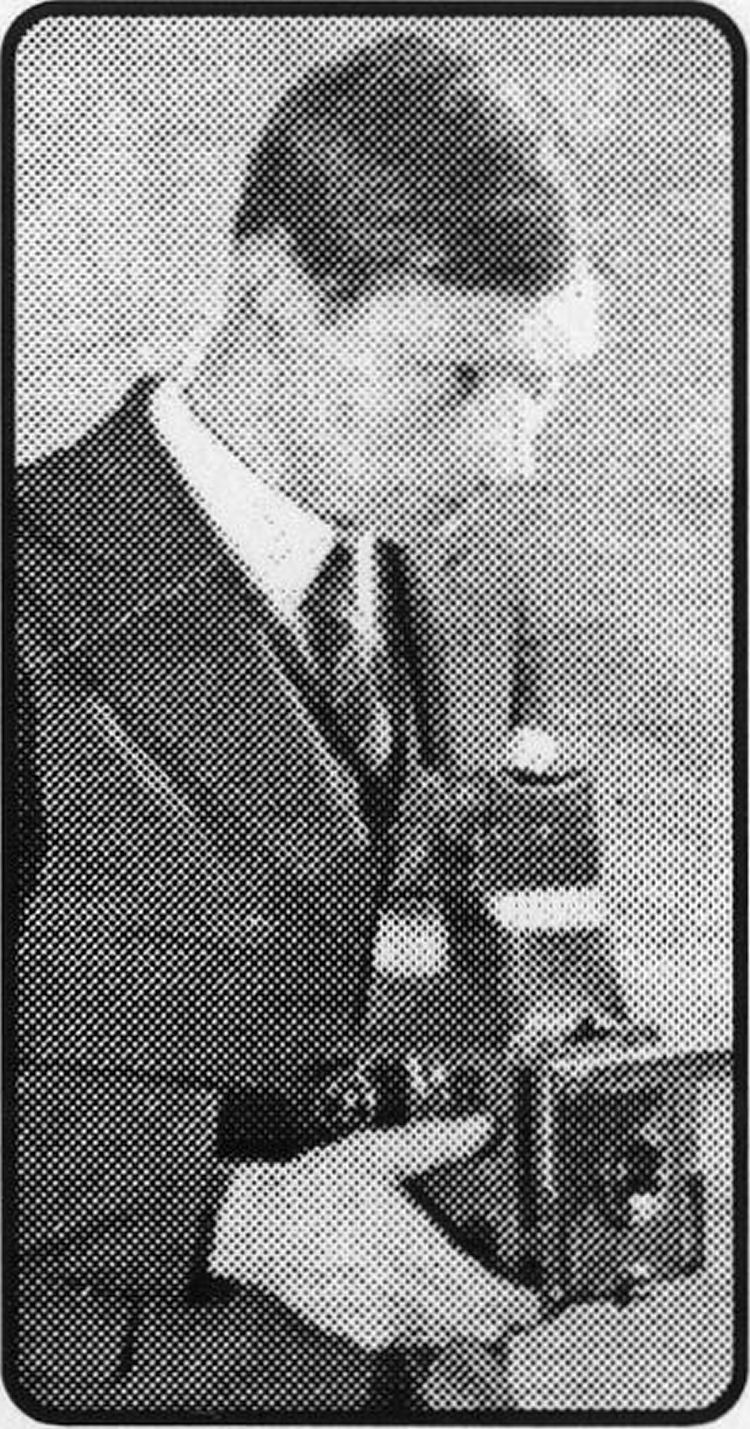
Published 12 October 2000
Happy snap!
REMEMBER the Memories pictures of the happy street party scenes in Bridge
Street - see picture top right - celebrating the Coronation in 1937 of King
George VI and Queen Elizabeth, now the Queen Mother, shown to us by local
historian Alan Taylor, who had copies made from old magic lantern slides?
that won a former amateur photographer a top prize in a competition.
That cash prize was to be the spur that prompted Mrs Hoad’s father, a
pharmacist in Folkestone, to take the plunge and set himself up in business
in his own shop.
Mr J.F. Smith’s pictures in the Herald created a great deal of interest and
Alan decided to send a copy of the articles to Mrs Hoad.
She was quite impressed by the quality of the colour prints made from the
slides and set about Mrs Gwen Hoad's parents, Mr & Mrs looking among J.F.
Smith snapped at the seaside by her late father’s a beach photographer
around 1930. papers t0 try
and discover what kind of camera he had used for his pictures.
And she came up with the two pictures on this page showing the camera he was
thought to have been using back in the thirties.
As luck would have it one of the old beach photographers snapped Gwen Hoad’s
parents around 1930 when Mr Smith had his camera with him.
That was before daughter Gwen was born.
It looks just like a plate camera I remember the Dover Express used to have
when I worked in the old Snargate Street, Dover offices as a young reporter.
But I can’t recall what make it was.
Gwen says her father still had it, and others, when he died, but she sold
them to a collector.
The other picture, right, was taken in 1935-37 by fellow Folkestone Camera
Club member E.F. Davidson. He was a Leica user - but this
Those colour slides, 2.5inches square, were given to Alan by Gwen Hoad,
living in Ashtead, Surrey and included a photograph
PARTY TIME: Left of the table from the front are: Dorothy Hussey, Mrs
Leggatt. Eddie Spelzine, Lucy Leggatt and Angela Sutton (junior): right:
from the front: Florence Morrison, Angelina Sutton, Mrs Ewins, Mrs Blackman.
Angela Philpott, Dolly Reed, Hester Sutton (who became Mrs Chambers) and
Rosie Sutton.
shot was not very
She also found details about the competition her father won, netting1 him
the grand sum of £200 for the best colour snapshot -quite a useful sum in
those days.
The colour film pioneers Dufay-Chromex of Aldwych whose films I recall using
40 years ago, put up £150 of the money and the Daily Express -which ran the
competition forked out £50.
The group picture, above, incidentally made one Sellindge
woman very happy It was the first time Mrs Lea Carter, of Swan Lane had seen
a picture of her great grandmother Mrs Leggatt who was pictured with her
daughter Lucy Happily Alan was able to provide her with a copy which she was
delighted * to present to her
grandma, Evelyn Leggatt aged 86.
Mr Smith was the secretary of the Folkestone Camera Club when he took the
national prize-winning colour photograph, which he gave the caption “Happy
smiles after
the Coronation Tea.”
From Frank Cooper; who also lives in Sellindge, comes a letter referring to
a recent article about Red Lion Square which, he said, stated there had
never been barges on Hythe Canal. He writes of a postcard sent to a
relative, George Harvey Cooper; whose family had the Lang-home Hotel most of
the 1800s.
This postcard refers to a passage boat service from Hythe to Appledore,
useful for people heading for Hastings, Rye and Brighton. It ran at 10.30am
daily except Sunday with return in the afternoon for connection to Dover -
with “Good fire in cabin in winter!" it stated.
In 1838 21 barges were in use on the canal and in 1877 a packet boat still
ran, used for the transport of road materials.
sharp.
original




 |
|
1900
Eleven tramcars planned to run through the town.
*1 Q BICYCLE maker Mr P. Morgan was .L«sV/Uexpanding and took over the
Shellons Street works of Folkestone & District Motor Co Ltd to set up a
motor garage for the repair and garaging of the growing number of local
motor vehicles, taking a large advertisement in the Herald. The paper’s
commercial correspondent wrote in glowing terms about the first three
years working In Folkestone of Foster's Laundry in Cheriton which, he
wrote,could Justifiably claim to be the largest laundry south of the
metropolis. Columns of the paper were being devoted to the latest
developments in the scheme for a local tramway system. Eleven tramcars,
with two extra as spares, were planned to run over three routes and were
expected to run for 16 hours a day, possibly less on Sundays, at about
6mph and clock a total of about 360,000 miles a year. Cars would cost
£8,100, line construction £68,500, power generating plant and car shed
£15,000 and land about £3,000. The cost might be cut by limiting the
track gauge to 3ft Bins. Heavy rain brought home to local people the
“intolerable neglect by the Council of public streets” which had been a
feature of the ‘season,’ wrote the editor.
|
|
1925
London honours for two Folkestone businesses.
4 QAP PHOTOGRAPHERS Halksworth Wheeler of JLViC.0 Folkestone had three
portraits chosen as well as other photographs for display in an
International exhibition in Piccadilly to mark the centenary of
photography. Martin Walters of Folkestone earned admiration and orders
at the national Motor Show held at Olympia where they exhibited a
“magnificent" Folkestone built Pullman limousine on a 40-50 Delage
chassis and an “extremely graceful” coupe body on a 14hp Delage chassis,
while Daimler displayed a Martin Walter cabriolet on their new 25-85 hp
chassis. Motor coachbuilding was thriving at that time in the town and
Martin Walter were currently building the latest type of Rolls-Royce
40-50 Phantom and a touring body on a 30-98 Vauxhaii chassis. A special
spray plant had been installed for a new nitro-celiulose paint finish.
The Town Crier, known as ‘Chopper’ Anderson, who was 76, took part in a
national competition to find the top man in his art. Sadly ‘Chopper’,
the eldest competitor didn’t win. Herald writer Felix was waxing lyrical
about the town’s famous railway viaduct with its 19 graceful arches and
harping back to the days when Cubitt’s masterpiece spanned the tiny
Foord community and no house stood near. A little stream, later enclosed
in a pipe, passed underneath it with poplars swaying in the breeze.
|
|
1950
Baptist community look over back 250 years.
1 QCftFOLKESTONE ; Baptist Church was celebrating its 250th Anniversary.
It was in 1720 that “the Gospel was first introduced to Folkestone by
Christians of the Baptist denomination” it is recorded in the official
records. The first chapel, illustrated in the Herald in 1925, was in
Mill Bay. The foundation stone of the old Baptist Church in Rendezvous
Street was laid in 1845 and a new church, called Salem Chapel, opened on
the same site in 1874. The anniversary was marked by the unveiling of a
new stained glass window to the memory of popular former Minister Dr
J.C. Carlile, who was the author of a book on wartime Folkestone. At a
special meeting of the Town Council it was decided to seek parliamentary
powers to borrow £11,500 for emergency repairs to Sandgate sea defences
where three stretches of the sea wall had either been breached by the
sea or had been seriously undermined. The wall had collapsed at Castle
Close (£6,000) and was in danger of doing so at Beach Court (£3.000.)
The third troublespot adjoined Durnford House. “Brass Knocker Street
Mourns Good Friend’ read the headline on a front page story about the
death of one of the fishing community’s best known characters, Mrs Lily
May wife of Bert May, of North Street.
|
|
1975
Local contractors Jenners celebrate their centenary.
4 C HISTORIC Mill House at Frogham was i O reprieved at the last minute,
after plans for the proposed M20 motorway were changed. But alight by
three young squatters to continue living there went on. The Department
of the Environment, which bought the properly to demolish it, sought an
eviction order against the squatters who offered £11 a week rent Shepway
Council had declined to use the property for temporary accommodation.
Although it was admitted Hythe’s 270ft long sewage outfall “leaked like
a sieve from the 100ft mark, plans for a £10,000 repair scheme were
criticised, some councillors fearing the work would lead to more
pollution of the beaches. But it was explained that it wasn't an
extension of the pipe that was proposed. UFOs - A series of triangles
cut into the ground on the west side of Caesar’s Camp could be the work
of “aliens” said Chris Rolfe, the local president of the Cosmic Society
Research Consortium. The Consortium was planning a three-day vigil front
the Camp, looking for Unidentified Flying Objects and was confident of
making a sighting. One of the town’s biggest building and civil
engineering contractors Jenners was celebrating its centenary. It had a
hand in building numerous local landmarks, such as the Welfare
Insurance/Sainsbury complex on the Leas, the Rotunda, St Saviour’s
Hospital at Hythe, wartime radar stations in Hellfire Corner and East
Kent Pfizer plants. |
|





